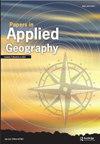Morphometric Analysis toward Mapping Relative Tectonic Activity of Lebanon
Q2 Social Sciences
引用次数: 0
Abstract
Abstract The analysis of geomorphic indices, computed using a digital elevation model and a geographical information system, was carried out to look for signs of tectonic activity in the river basins of Lebanon. The tectonic activity analysis was conducted on the thirty-eight basins through two methods: (1) shape-based, which estimates topography (stream gradient, hypsometry integral, and valley floor), form (asymmetry factor and basin shape), and sinuosity indices (fractal dimension of drainage patterns and mountain front), and (2) terrain-based, which extracts terrain (stream power index, valley depth, flow width, and relief ratio), and surface fractal dimension complexity indices. The results obtained were combined to produce two Relative Active Tectonic Maps (RATMshape and RATMterrain). This study demonstrated that active tectonics matched well with the extracted geomorphic indices and allowed to define the relative tectonic activity in Lebanon: about 65% of the basins correspond to class 1 low; 28% to class 2 moderate; 5% to class 3 high; and 2% to class 4 very high. The east part of the Yammouneh fault and the entire Serghaya fault are moderate to highly active based on the relative tectonic activity analysis. The more active tectonic areas are concentrated in the north ends of Lebanon, while moderate tectonics are focused on the south ends. The entire Rachaya and Roum faults are low to moderately active. The northern part of the Lebanon mountain range, which sits west of the Yammouneh fault, has exceptionally high relative tectonic activity.黎巴嫩相对构造活动制图的形态计量学分析
摘要利用数字高程模型和地理信息系统对黎巴嫩流域的地貌指数进行了分析,以寻找构造活动的迹象。通过两种方法对38个盆地进行构造活动分析:(1)基于形状的地形(河流梯度、坡度积分和谷底)、形式(不对称因子和盆地形状)和曲度指数(流域格局和山前分形维数);(2)基于地形的地形(河流动力指数、山谷深度、流宽、起伏比)和地表分形维数复杂性指数的提取。将所得结果进行综合处理,得到两幅相对活动构造图(ratm - shape和ratm - terrain)。研究表明,活动构造与提取的地貌指标匹配良好,可以确定黎巴嫩的相对构造活动:约65%的盆地对应1类低;28%为中等2级;5%至3级高;4级占2%,非常高。相对构造活动性分析表明,喜马拉雅断裂带东段和整个谢尔盖亚断裂带处于中至高度活动性。较为活跃的构造区集中在黎巴嫩的北端,而温和的构造区则集中在黎巴嫩的南端。整个拉查亚断层和鲁姆断层都处于低到中等活动性。黎巴嫩山脉的北部,位于Yammouneh断层的西部,具有异常高的相对构造活动。
本文章由计算机程序翻译,如有差异,请以英文原文为准。
求助全文
约1分钟内获得全文
求助全文

 求助内容:
求助内容: 应助结果提醒方式:
应助结果提醒方式:


